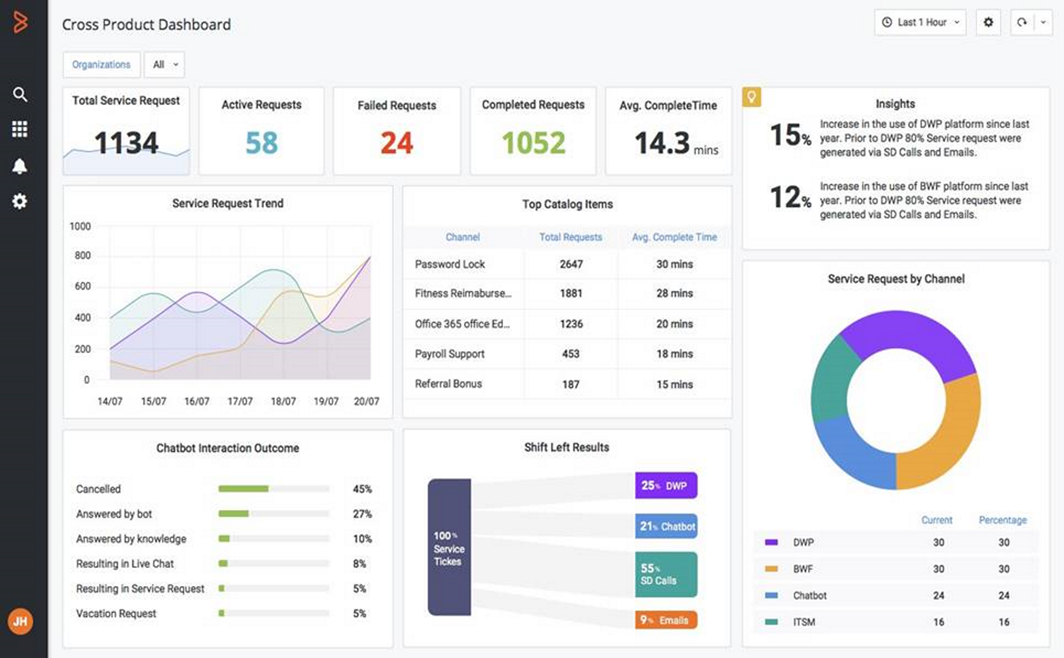Practicing observability is great, but gaps in the details that support the underlying structure of an application will skew its benefits, and negatively impact the customer, which no smart chief information officer (CIO) should accept. Today’s complex hybrid environments are continually pressed to move faster, and keeping specific information within operational silos is a sure path to failure.
Organizations can no longer just monitor respective areas as separate identifiers. They must also:
- Collect all data from disparate sources
- Analyze the collective data all together with artificial intelligence and machine learning (AI/ML) to obtain intelligent insights
- Provide visibility into the intelligent insights via a flexible interface
- Retain all history and underlying data for deeper dives
Shared responsibility
The overall health of a service is dependent on many factors, each of which requires detailed monitoring. Compare this to the process of purchasing a home. Would anyone buy a home after only seeing it from the outside? Of course not. Gathering collective information about the foundation, the heating and electrical systems, and the overall aesthetics are all part of the decision process.
For IT organizations, the infrastructure, user experience, application or system logs/traces, and AI/ML-derived intelligent insights gathered from all these sources are necessary to making collective decisions. As more organizations move to a shared responsibility model, they need solutions that provide collective visibility into all pertinent data.
Problem indicators can come from various sources, so it’s no longer acceptable to be responsible for only a subset of application behavior within disparate parts of the enterprise. The whole ecosystem must accept responsibility—with a blameless culture—but the necessary tooling is required to be successful. Consider BMC Helix, which is built upon this approach.
Persona-based views
In the home-purchasing scenario, not all home buyers prioritize the aspects of a home in the same way. Families with small children may be interested in the school district while couples in a later stage of life may be more interested in lower taxes, but all information gathered is taken into consideration when making the decision.
In application support, access to the information is pertinent, but so is the ability to personalize the view of all the data available. Different specialists may need to look deeper into certain indicators to provide expert opinions on their impact on the health of a service. Some indicators are symptoms rather than causes, so all teams should have access to all the information so they can better understand the way the system behaves and interacts.
Over time, configurations can be adjusted based on all the information available to all stakeholders, while also allowing each persona to customize their view to best perform their respective function. Since all stakeholders can visualize what they need when they need it, the service—and user satisfaction—will continue to improve.

Reduced effort
If we return to the home-buying scenario, families typically research and tour homes together versus doing so separately. They make informed decisions based on what each of them interpreted from their collective experience.
In large organizations, efforts are often duplicated when information is siloed, which causes processes to break down. Duplicated efforts occur when tickets are assigned to teams without giving the assignee access to the full picture. The assignee follows the process used by their team, while other members of the organization are doing the same for their respective areas. That’s inefficient.
No organization wants to play the blame game; however, this issue occurs too often when information access is limited to each specific area and teams retreat to their respective corners to examine and diagnosis a situation. When everyone has access to view all the data from AI/ML and the underlying details that support it at the same time, hotspots are clearly observed in tandem by all parties for faster root cause identification and remediation and happy customers. And the organization is more efficient because it reduced duplicated effort.
Conclusion
A shared information culture allows for broad dissemination of information and creates an open-concept, cohesive responsibility model. The full benefits of observability can be achieved by giving all stakeholders access to the same intelligent insights and underlying data, and allowing them to customize their view. From there, they can diagnosis an issue from their unique perspective and gain a collective understanding of the negative and positive impact of the behavior on other areas of the business. Just like the family purchasing a home, everyone’s perspectives are taken into consideration because they each have all the information they need to make an informed decision.
To learn more about collecting monitoring data for analysis and visibility, check out BMC Helix Operations Management with AIOps.
BMC Helix includes a list of plugins to access disparate data. The newly released open-source BMC Helix Data Source plugin is now available on the Grafana plugins listing page.
For details about visualizing monitoring data within the BMC Dashboards, review these instructional videos:
- BMC Helix Dashboards: Where to Start
- BMC Helix Dashboards: Using Variables
- BMC Helix Dashboards: Advanced Dashboards – Part 1
- BMC Helix Dashboards: Advanced Dashboards – Part 2
These postings are my own and do not necessarily represent BMC's position, strategies, or opinion.
See an error or have a suggestion? Please let us know by emailing blogs@bmc.com.






